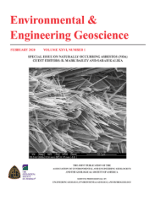
ENVIRONMENTAL & ENGINEERING GEOSCIENCE
Scope & Guideline
Advancing Sustainable Solutions in Geoscience and Engineering
Introduction
Aims and Scopes
- Geohazards and Risk Assessment:
The journal extensively covers topics related to geohazards such as landslides, floods, and earthquakes, focusing on risk assessment methodologies to mitigate their impact on infrastructure and communities. - Hydrogeology and Water Quality:
Research on groundwater systems, water quality monitoring, and the impacts of land use on hydrological cycles is a core area, emphasizing sustainable management of water resources. - Engineering Geology and Infrastructure:
The journal addresses engineering geology principles in the design and assessment of infrastructure, including dams, levees, and urban developments, ensuring safety and sustainability. - Environmental Impacts of Geological Processes:
Studies exploring the environmental impacts of geological processes, such as contamination from mining activities or the effects of natural disasters on ecosystems, are critical to this journal. - Innovative Monitoring and Modeling Techniques:
The use of advanced technologies like remote sensing, InSAR, and UAV-based photogrammetry for monitoring geological phenomena is a significant methodological focus, enhancing data collection and analysis.
Trending and Emerging
- Climate Change Impact Studies:
There is an increasing focus on the effects of climate change on geohazards, such as landslides and flooding, reflecting a growing recognition of the need to address climate-related risks in engineering and environmental planning. - Integrated Monitoring Approaches:
A trend towards multi-sensor and integrated monitoring techniques, combining traditional methods with cutting-edge technologies like UAVs and remote sensing, is gaining traction for enhanced geohazard detection and management. - Sustainable Resource Management:
Research emphasizing sustainable practices in resource extraction and land use management is on the rise, aligning with global sustainability goals and the need for responsible environmental stewardship. - Health and Environmental Interactions:
Emerging studies that link environmental changes to public health outcomes, particularly in the context of pollution and natural disasters, are becoming more prominent, indicating an interdisciplinary approach to geoscience. - Advanced Modeling Techniques:
The journal is increasingly publishing work that utilizes complex modeling techniques, such as machine learning and probabilistic models, to predict geohazards and evaluate risk, showcasing a shift towards data-driven decision-making.
Declining or Waning
- Historical Geological Studies:
There has been a noticeable decrease in papers focusing solely on historical geological events or studies that do not incorporate modern analytical techniques, as the journal shifts towards more applied and current issues. - Traditional Soil Mechanics:
Research centered on conventional soil mechanics appears to be less frequent, indicating a potential decline in interest in basic soil behavior studies compared to more complex interactions in geohazards. - Karst Studies:
Although still important, the frequency of studies specifically focusing on karst systems has reduced, possibly due to the journal's broader focus on more pressing environmental challenges. - Static Risk Assessments:
There seems to be a decline in publications that rely on static risk assessment models without integrating dynamic monitoring or predictive analytics, reflecting a shift towards more comprehensive and adaptable methodologies.
Similar Journals

Research in Cold and Arid Regions
Connecting scholars to the pulse of Earth's harshest climates.Research in Cold and Arid Regions, published by KEAI PUBLISHING LTD, is a premier journal dedicated to advancing knowledge in the fields of Earth-Surface Processes, Environmental Engineering, and Geosciences. With an ISSN of 2097-1583 and an E-ISSN of 2949-7302, this journal aims to provide a platform for researchers, professionals, and students to share their findings on the complexities of cold and arid environments, which have increasing significance in the context of climate change. The journal holds a Q3 ranking in multiple categories for 2023, reflecting its commitment to quality scholarship, though it also sits at the cusp of enhancing its potential impact in Geotechnical Engineering and Engineering Geology. Open Access options allow for wider dissemination of research findings, ensuring that valuable insights are accessible to a global audience. Based in Beijing, China, the journal is strategically positioned to address the unique challenges faced by arid and cold regions worldwide, making it an essential resource for scholars and practitioners focused on sustainable solutions for environmental issues.

Geomechanics for Energy and the Environment
Transforming Geotechnical Engineering for a Greener TomorrowGeomechanics for Energy and the Environment, published by ELSEVIER, stands as a premier journal in the fields of geotechnical engineering, Earth sciences, and risk assessment. With an impressive impact factor and ranking in the Q1 category across multiple relevant disciplines including Computers in Earth Sciences and Engineering Geology, this journal serves as a critical platform for groundbreaking research and innovation from 2015 to 2024. Located in the Netherlands, it aims to bridge the gap between geomechanics and energy solutions, making it indispensable for professionals and academics focused on sustainability and environmental impacts. Although it operates on a traditional access model, the rich and varied content published in this journal is essential for those at the forefront of research, helping to foster a deeper understanding of the interplay between geomechanical processes and environmental challenges. Your contributions to this journal not only enhance scientific dialogue but also pave the way for advancements in risk management and geotechnical practices that are crucial for the future.
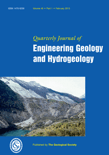
Quarterly Journal of Engineering Geology and Hydrogeology
Bridging Theory and Practice in Earth Sciences.The Quarterly Journal of Engineering Geology and Hydrogeology, published by GEOLOGICAL SOC PUBL HOUSE, stands as a crucial resource in the realms of Earth and Planetary Sciences, Geology, and Geotechnical Engineering. With an ISSN of 1470-9236 and its E-ISSN 2041-4803, this esteemed journal has been committed to disseminating high-quality research from its inception in 2001 through to 2024. Although it operates under traditional subscription access, the journal remains dedicated to providing a platform for rigorous scientific discourse and knowledge exchange. In 2023, it was recognized with a Q3 category rank across multiple disciplines, reflecting its growing influence and solid standing; it ranks #105 out of 321 in Earth and Planetary Sciences: Geology, and #97 out of 229 in Geotechnical Engineering and Engineering Geology. The journal aims to bridge the gap between theoretical research and practical applications, making it an invaluable tool for researchers, professionals, and students eager to advance their knowledge in the interrelated fields of engineering geology and hydrogeology.

Journal of the Korean Earth Science Society
Exploring the Depths of Earth's MysteriesJournal of the Korean Earth Science Society is a leading peer-reviewed publication dedicated to advancing research in the dynamic field of Earth sciences. Published by the Korean Earth Science Society, this journal serves as a vital platform for disseminating original research, reviews, and significant advancements in areas such as geology, mineralogy, geophysics, and environmental science. With its ISSN 1225-6692 and E-ISSN 2287-4518, the journal is recognized for its commitment to quality and rigor. Although it does not provide open access options at present, it continues to play a crucial role in informing the scholarly community and enhancing the understanding of Earth science phenomena, thus bridging knowledge gaps and fostering collaboration among researchers, professionals, and students alike. For those interested in the latest developments and innovative research findings in Earth sciences, the Journal of the Korean Earth Science Society remains an indispensable resource.
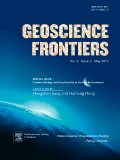
Geoscience Frontiers
Advancing Earth Sciences Through Open AccessGeoscience Frontiers is a premier open-access journal that has been at the forefront of disseminating impactful research in the field of Earth and Planetary Sciences since its inception in 2010. Published by China University of Geosciences, Beijing, this journal operates from the Netherlands and has gained recognition for its rigorous peer-review process and high standards of scholarship, earning a distinguished position as Q1 in the Earth and Planetary Sciences category. With a Scopus ranking of 5 out of 195, placing it in the 97th percentile, it reflects the journal's commitment to addressing global geological challenges and advancing our understanding of the Earth’s dynamic systems. As an open-access platform, Geoscience Frontiers ensures that vital research is widely accessible, fostering collaboration and innovation among researchers, professionals, and students alike. By providing a forum for cutting-edge discoveries and theories, the journal plays a critical role in shaping the future of geoscientific research and education.

Frontiers in Earth Science
Bridging Disciplines to Solve Earth's ChallengesFrontiers in Earth Science is a leading open-access journal published by FRONTIERS MEDIA SA, based in Switzerland. With its ISSN N/A and E-ISSN 2296-6463, this journal has firmly established itself in the realm of Earth and Planetary Sciences, evidenced by its exceptional Q1 ranking in the 2023 category of Earth and Planetary Sciences (miscellaneous) and a solid position of Rank #66/195 in Scopus, placing it in the 66th percentile among its peers. Since its inception in 2013, Frontiers in Earth Science has embraced the open access model, promoting widespread dissemination and accessibility of research findings. The journal covers a broad scope, including areas such as geology, meteorology, oceanography, and environmental science, fostering interdisciplinary communication and advancement. Researchers, professionals, and students looking to stay at the forefront of Earth science research will find an invaluable resource in this journal, which not only curates high-quality research but also supports innovative and impactful studies that address the pressing challenges facing our planet today.
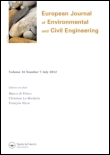
European Journal of Environmental and Civil Engineering
Fostering Dialogue for Sustainable Development in EngineeringThe European Journal of Environmental and Civil Engineering, published by Taylor & Francis Ltd, is a prestigious peer-reviewed journal that serves as a vital platform for advancing knowledge in the fields of Civil and Structural Engineering as well as Environmental Engineering. With an impressive impact factor and categorized in the Q2 quartile for both engineering fields, this journal occupies a significant position in the scholarly community. Its focused scope encompasses innovative research, case studies, and practical applications that address contemporary environmental and infrastructural challenges. Researchers, professionals, and students alike benefit from the journal's commitment to high-quality discourse, as evidenced by its Scopus rankings, which place it in the top 30% in Civil and Structural Engineering and the top 40% in Environmental Engineering. Through the publication of cutting-edge studies and a commitment to fostering interdisciplinary dialogue, the European Journal of Environmental and Civil Engineering remains an essential resource for those dedicated to improving our built environment and safeguarding our natural resources.

DOKLADY EARTH SCIENCES
Shaping the Future of Earth Science ExplorationDOKLADY EARTH SCIENCES is a reputable journal published by MAIK NAUKA/INTERPERIODICA/SPRINGER, focusing on the dynamic field of Earth and Planetary Sciences. With an ISSN of 1028-334X and E-ISSN 1531-8354, this journal offers a platform for researchers to disseminate their findings and insights that contribute to our understanding of Earth systems over a continuous publishing span from 1998 to 2024. It currently holds a Q3 quartile ranking in the Earth and Planetary Sciences category, reflecting an emerging yet significant impact within its field, evidenced by its Scopus ranks where it stands at 123rd in general Earth sciences and 113th in miscellaneous Earth sciences. DOKLADY EARTH SCIENCES aims to bridge research gaps and foster collaboration among a diverse audience including researchers, professionals, and students committed to advancing knowledge in geoscience. The journal stands as a vital resource for those seeking to explore contemporary challenges and innovations within the realm of Earth sciences.
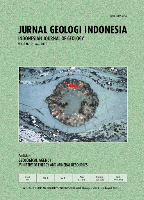
Indonesian Journal of Geoscience
Exploring Earth's Mysteries, One Study at a Time.Indonesian Journal of Geoscience, published by the GEOLOGICAL AGENCY, is a vital platform for sharing cutting-edge research in the field of Earth and Planetary Sciences. With an ISSN of 2355-9314 and E-ISSN of 2355-9306, this open-access journal has been making significant contributions to the geoscientific community since its establishment in 2013. Operating out of Bandung, Indonesia, the journal is dedicated to disseminating high-quality research across diverse areas, making it an essential resource for researchers, professionals, and students alike. Recognized in the 2023 Q2 category in Earth and Planetary Sciences, it currently ranks #134/195 among general Earth and Planetary Sciences journals in Scopus, reflecting its growing prominence and academic rigor. The journal seeks to foster scientific discussions by publishing original research, reviews, and case studies that address contemporary challenges and advancements in geoscience, thus contributing to a deeper understanding of our planet. With its commitment to open access, the Indonesian Journal of Geoscience ensures that vital research is accessible to a global audience, encouraging collaboration and innovation in the field.
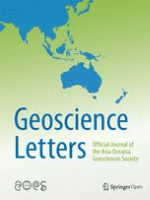
Geoscience Letters
Exploring the Depths of Earth and BeyondGeoscience Letters, published by Springer, is a prominent open-access journal in the field of Earth and Planetary Sciences, recognized for its dedication to advancing knowledge and research in this vital area of study. With a reported impact factor that reflects its esteemed position—ranking in the Q1 quartile of Earth and Planetary Sciences, particularly as the journal ranks #48 out of 195 in the general category according to Scopus—the journal serves as a vital resource for researchers, professionals, and students. Since its inception in 2014, Geoscience Letters has facilitated the dissemination of high-quality research and critical insights, aiming to bridge the gap between scientific discovery and societal needs. Its commitment to open access ensures that the latest findings are readily available to a global audience, thus enhancing collaboration and innovation within the geosciences community.